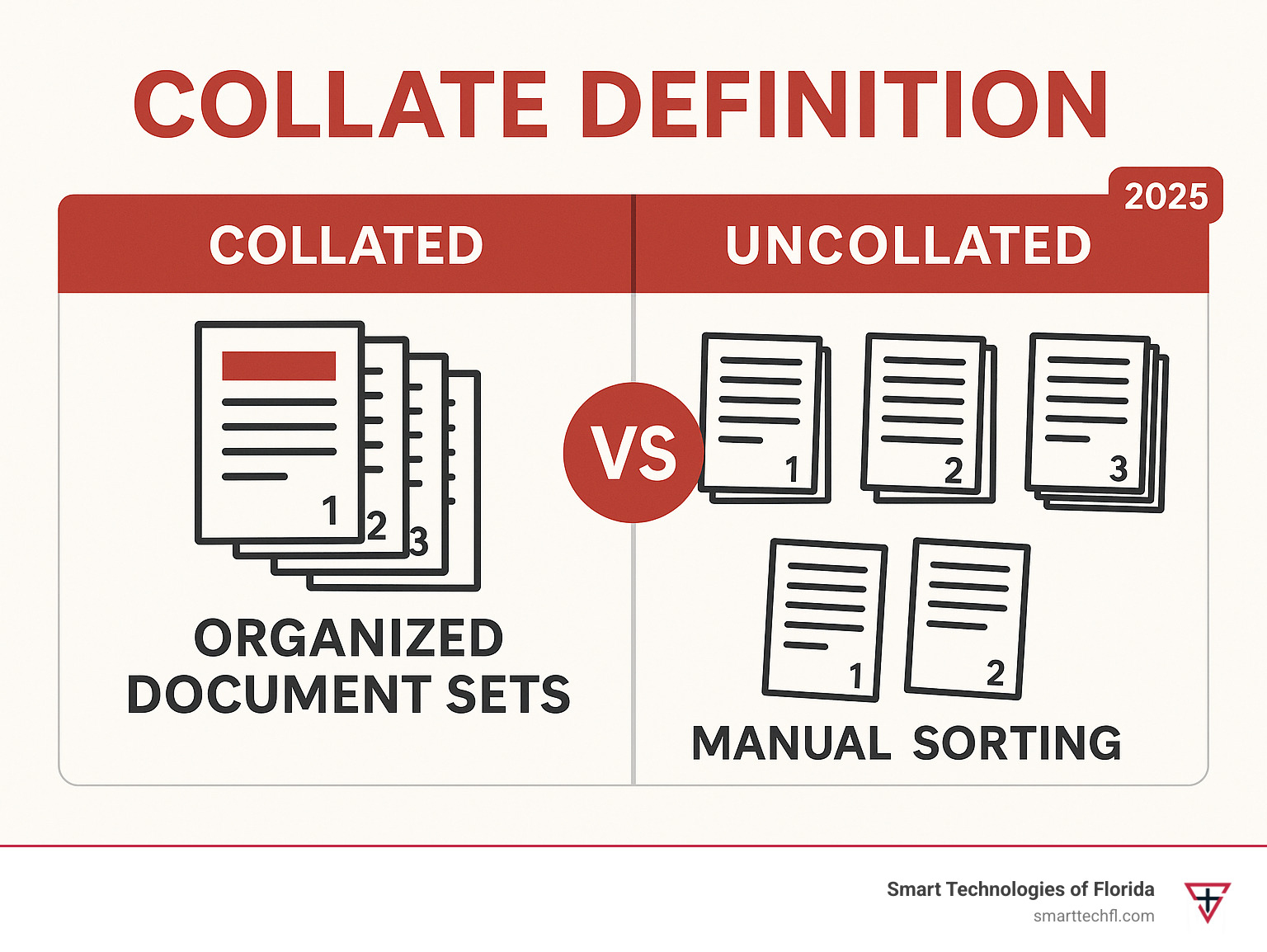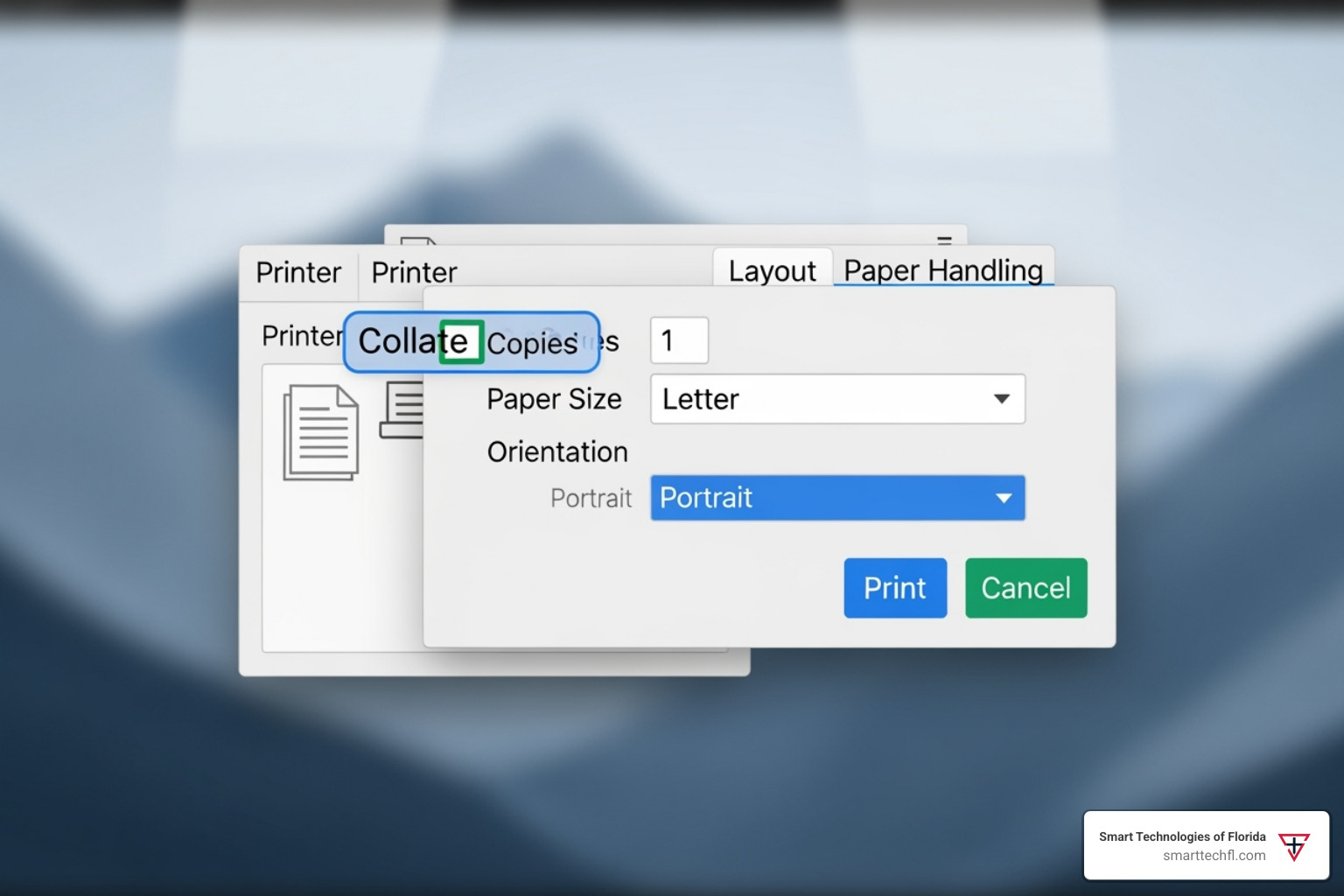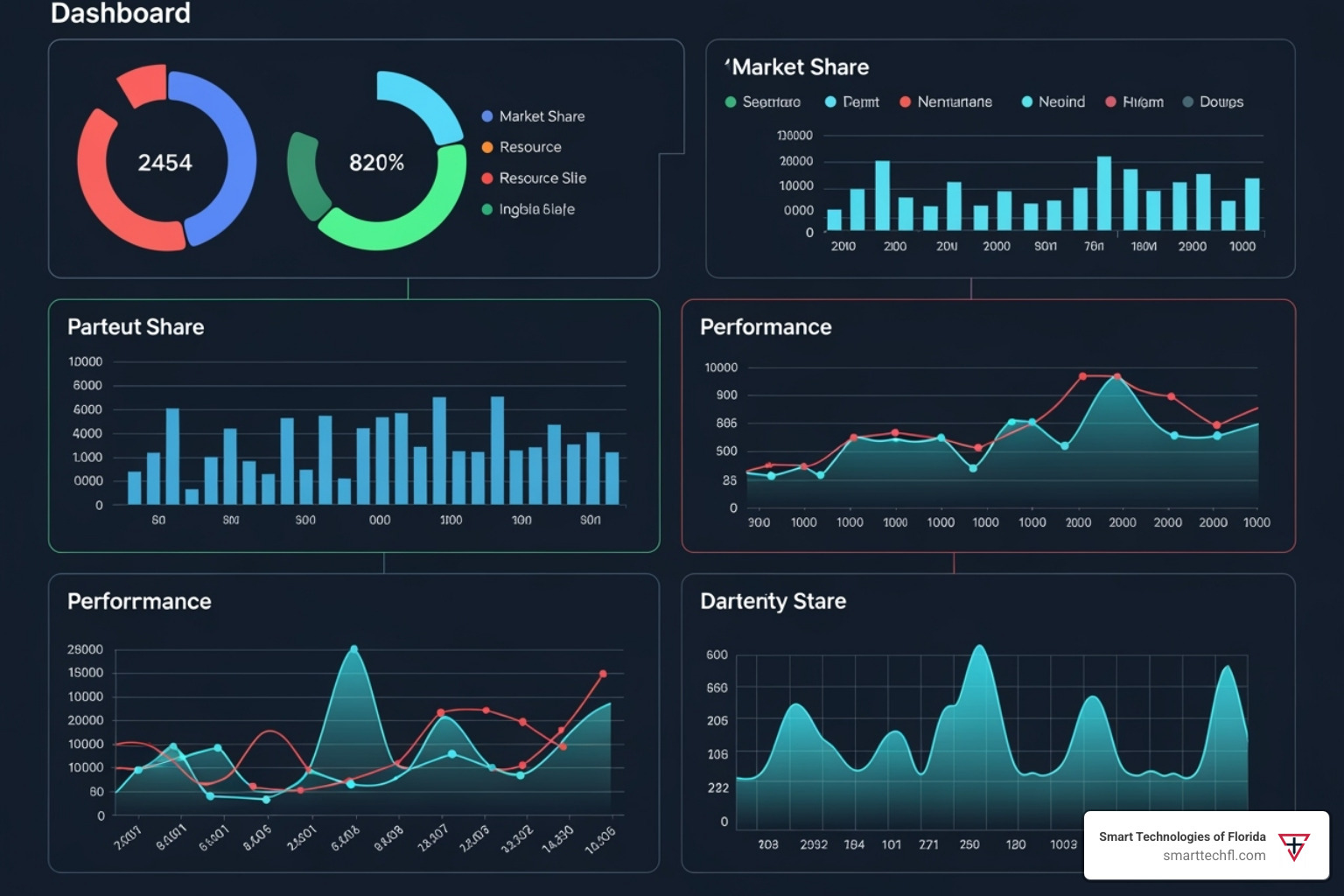Collate Explained: From Definition to Application
The collate definition is simpler than you might think, yet this single word carries significant power in both printing and data management. At its core, collate means to gather and arrange information or documents in proper order, or to compare different sources critically to find similarities and differences.
Quick Definition Summary:
- Primary meaning: Arrange pages or documents in correct sequential order
- Secondary meaning: Compare and analyze information from different sources
- Most common use: Printing multiple copies of multi-page documents
- Business benefit: Saves time and reduces errors in document handling
You’ve probably seen the “collate” checkbox in your printer settings hundreds of times. When enabled, it ensures your 20-page report prints as 10 complete sets (pages 1-20, 1-20, 1-20) instead of 10 copies of page 1, then 10 copies of page 2, and so on. This simple feature can save hours of manual sorting.
But collating goes far beyond printing. Researchers collate data from multiple studies to identify patterns. Genealogists collate historical records to verify family trees. Even journalists collate information from various sources to build comprehensive stories.
The word comes from the Latin collatus, meaning “brought together” – which perfectly captures what collating does in any context. Whether you’re organizing printed documents or comparing data sets, you’re bringing separate pieces together into a meaningful whole.
For business owners, understanding when and how to collate can streamline operations, reduce manual work, and improve accuracy across everything from customer reports to internal documentation.

The Primary Collate Definition and Its Dual Meanings
Every word has a story, and “collate” tells a particularly interesting one. Understanding where this word comes from helps explain why it’s become such a versatile term in modern business and technology.
The collate definition traces back to ancient Rome, where the Latin word collatus meant “to bring together.” This simple concept of gathering separate things into one place forms the foundation of everything we do when we collate today.
Think about it – whether you’re organizing printed documents or comparing research data, you’re essentially doing what the Romans described centuries ago: bringing scattered pieces together to create something more useful and complete.
Modern usage has evolved into two core meanings that might seem different on the surface but share that same “bringing together” DNA:
Assembling in order represents the organizational side of collating. This is what most people think of when they hear the word – taking loose pages, documents, or data and arranging them in the correct sequence. It’s methodical, systematic, and incredibly practical.
Critical comparison takes collating to a deeper level. Here, you’re not just organizing – you’re analyzing. You’re bringing different sources together specifically to identify similarities, spot differences, and uncover insights that weren’t visible when the information was scattered.

Understanding the Core Collate Definition
The beauty of the collate definition lies in its flexibility. At its most basic level, gathering information and arranging in sequence forms the foundation of countless daily tasks. When you sort your mail by date or organize files alphabetically, you’re collating.
But the real power emerges when you add the analytical component. Comparing critically transforms simple organization into strategic insight. Instead of just putting things in order, you’re identifying similarities and finding differences that can reveal patterns, inconsistencies, or opportunities.
This dual nature makes collating invaluable across industries. A financial analyst doesn’t just arrange quarterly reports chronologically – they compare them to spot trends and anomalies. A project manager doesn’t just organize team updates – they analyze them to identify bottlenecks and successes.
From Simple Sorting to Complex Analysis
The range of collating applications spans from what some might call a mindless job to a sophisticated analytical task. Both have their place, and both add real value to business operations.
Arranging papers represents collating at its most straightforward. When your printer spits out multiple copies of a presentation with all the page 1s together, all the page 2s together, and so on, manually sorting them into complete sets is pure collating. It’s repetitive, sure, but it’s also essential for creating usable documents.
Analyzing data showcases collating’s intellectual side. Genealogists collating data from birth certificates, census records, and family letters don’t just organize chronologically – they cross-reference information to verify relationships and uncover family stories. Sometimes they find delightful surprises, like a great-great-grandmother who was apparently born after her own daughter (usually a clue that someone’s dates are wrong!).
Scientific research demonstrates collating’s most sophisticated applications. When researchers collated data for all seven species of marine turtles, they weren’t just organizing information from hundreds of sources. They were synthesizing findings to understand global conservation patterns and identify critical gaps in protection efforts.
This progression from simple sorting to complex analysis shows why the collate definition remains relevant across so many fields. Whether you’re preparing presentation packets or conducting groundbreaking research, you’re participating in that same fundamental human activity: bringing scattered information together to create something more valuable than the sum of its parts.
Collate in Action: Printing and Document Management
When most people hear “collate,” their minds immediately jump to that little checkbox in their printer settings. And honestly? That’s perfectly reasonable. While the collate definition spans many fields, printing is where this handy feature truly shines in everyday business life.
Think about it: you’re rushing to prepare materials for an important client meeting, and you need 15 copies of a 20-page proposal. Without collating, you’d be stuck playing a frustrating game of paper shuffle, trying to sort through 300 individual sheets. With collating? Your printer does all the heavy lifting, delivering neat stacks of complete documents ready to impress.
This simple function has revolutionized office productivity and document management, changing what used to be a tedious manual task into something that happens automatically in the background.

The Practical Collate Definition for Printing
In the printing world, the collate definition gets refreshingly specific. It means your printer will arrange printed sheets in proper sequential order, creating complete sets of your multi-page document. Instead of giving you a chaotic pile of papers, it hands you organized, ready-to-use documents.
Here’s how it works in real life. Let’s say you’re printing 10 copies of a 5-page training manual. Without collating, your printer thinks it’s being helpful by giving you all 10 copies of page 1, then all 10 copies of page 2, and so on. You end up with five separate stacks that you’ll need to manually weave together into complete manuals.
With collating enabled, your printer takes a completely different approach. It prints one complete set (pages 1 through 5), then another complete set, then another. By the time it’s finished, you have 10 perfectly assembled manuals sitting in your output tray.
The difference is like having a personal assistant who understands that you need finished products, not puzzle pieces. As we explain in our detailed guide on what does collate mean when printing, this feature eliminates countless hours of manual sorting and virtually guarantees error-free document assembly.
Collated vs. Uncollated Printing
The contrast between collated and uncollated printing becomes crystal clear when you see them side by side. Collated printing follows a logical pattern, printing complete sets one after another (for example, pages 1, 2, and 3, followed by another complete set of pages 1, 2, and 3). Each number represents a page, and you can see how complete documents emerge naturally. Uncollated printing follows a different logic, printing all copies of one page before moving to the next (for example, all copies of page 1, then all copies of page 2, and so on). All the same pages are grouped together.
| Feature | Collated Printing | Uncollated Printing |
|---|---|---|
| Output Order | Prints complete sets sequentially (e.g., Page 1-2-3, then Page 1-2-3) | Prints all copies of each page together (e.g., Page 1-1-1, then Page 2-2-2) |
| Manual Work | None – documents ready to use | Significant sorting required |
| Error Risk | Minimal – automated accuracy | Higher – human sorting mistakes |
| Time Investment | Just the printing time | Printing time plus manual assembly |
The visual difference is striking too. Collated output looks like a neat row of finished booklets, while uncollated output resembles ingredient piles waiting for someone to cook them into something useful.
Key Benefits of Collated Printing
The advantages of collated printing go far beyond mere convenience. Time-saving tops the list – and we’re talking about serious time savings. Picture printing 50 copies of a 30-page employee handbook without collating. That’s 1,500 individual sheets you’d need to sort by hand. With collating, you walk away from the printer with 50 complete handbooks.
Accuracy becomes automatic when you let the printer handle the sorting. Human error creeps in surprisingly easily when you’re manually organizing hundreds of pages. A missing page here, a duplicate there, pages in the wrong order – these mistakes disappear with collated printing.
Professionalism matters more than many people realize. When you hand someone a perfectly organized document, it sends a subtle but powerful message about your attention to detail and operational efficiency. It’s one of those small touches that lift your business image.
The convenience factor can’t be overstated either. Documents emerge from the printer completely ready for distribution, binding, or filing. No sorting tables, no page counting, no double-checking – just grab and go.
For a deeper dive into these advantages, check out our comprehensive article on the benefits of collating when printing.
When to Use Collated vs. Uncollated
Most of the time, collated printing is your best friend. Reports and presentations are natural fits – when you’re preparing materials for a board meeting or client presentation, you want each attendee to receive a complete, properly ordered set. Training materials and manuals depend on logical page flow, making collating essential for effective learning.
Information packets become effortless to distribute when they’re pre-assembled, and test booklets for educational settings practically demand collated printing to ensure fair, organized testing conditions.
But uncollated printing has its place too. Booklet production sometimes requires a specific page arrangement for binding purposes. Quality control situations might call for examining multiple copies of the same page simultaneously. Single-page documents make the collate function irrelevant – there’s nothing to sort.
The key is matching your printing method to your end goal. For most business applications, collated printing delivers the efficiency and professionalism that keeps operations running smoothly.
Beyond the Printer: Collating Data and Information
While the collate definition might first come to mind when you’re staring at that checkbox in your printer settings, the real magic happens when we step into data and information. Think about it – we live in an age where businesses are drowning in data from dozens of different sources. The ability to collate this information effectively can make the difference between insight and overwhelm.

When we move beyond physical pages to digital information, collating becomes less about neat stacks of paper and more about creating meaningful connections between scattered pieces of data. It’s like being a detective who needs to piece together clues from different crime scenes to solve the case.
How ‘Collate’ Applies to Data and Research
In the digital field, the collate definition expands to include some pretty sophisticated processes. Comparing texts becomes crucial when scholars examine different versions of historical documents – imagine trying to figure out which version of an ancient manuscript is most accurate by studying variations across multiple copies.
Merging data sets is where things get really interesting for businesses. Picture a marketing team trying to understand their customer journey. They need to bring together website analytics, email campaign results, social media engagement, and sales data. Each system speaks a different language, but when you collate them properly, suddenly you can see the full story of how customers interact with your brand.
The process of verifying information through collation acts like a built-in fact-checker. When multiple independent sources tell you the same thing, you can feel confident about moving forward. It’s the difference between making decisions based on a hunch and making them based on solid evidence.
Integrating sources takes this one step further. Implementing tools that collate and merge data from multiple sources doesn’t just organize information – it creates new insights that wouldn’t be visible when looking at each source alone. It’s like finally seeing the forest instead of just individual trees.
Real-World Examples Across Industries
The beauty of data collation shows up everywhere once you start looking for it. Scientific research teams routinely collate findings from hundreds of studies to identify patterns that no single experiment could reveal. When researchers need to understand something as complex as climate change or disease progression, they’re essentially master collators, bringing together evidence from around the world.
Market analysis has become almost entirely dependent on effective collation. Modern businesses pull customer feedback from review sites, sales figures from multiple channels, social media sentiment, and competitor intelligence. Without proper collation, this information would just sit in separate silos, useless and overwhelming.
In SEO and PPC campaigns, marketing teams live and breathe collated data. They’re constantly bringing together search rankings, click-through rates, conversion data, and cost metrics to understand what’s working and what isn’t. The ability to see all this information in one coherent view transforms random numbers into actionable strategy.
Legal professionals might seem old-school, but they’re actually master collators. Building a case means gathering evidence from witness statements, documents, precedents, and expert opinions. Each piece might seem insignificant alone, but collated together, they tell a compelling story that can win or lose a case.
Journalism relies heavily on collation too, especially investigative reporting. A journalist working on a complex story might spend weeks collating interviews, documents, public records, and background research. The invisible work of organizing and cross-referencing all this material is what transforms a collection of facts into a story that makes sense to readers.
What makes all these examples powerful is that they demonstrate how the collate definition has evolved from simple document sorting into a critical thinking skill that drives decision-making across every industry.
Specialized Meanings of Collate
The collate definition extends far beyond printing and data analysis into some fascinating specialized areas. These niche applications show just how versatile this word really is, and understanding them gives you a complete picture of what collating means across different fields.
The Legal Definition of Collate
Here’s where things get interesting – and a bit technical. In Louisiana’s civil law system, the collate definition takes on a completely different meaning that has nothing to do with organizing papers or comparing data.
In this legal context, to collate means returning property or gifts to an estate so everything can be divided fairly among heirs. Think of it this way: if your parents gave you a $50,000 down payment for your house while they were alive, but your sibling didn’t receive anything similar, you might need to “collate” that gift back into the estate when your parents pass away.
This doesn’t mean you have to give the money back. Instead, the $50,000 gets counted as part of your inheritance when everything is divided up. So if the total estate is worth $200,000, and there are two children, instead of each getting $100,000, the calculations would account for that earlier gift to ensure fairness.
It’s a fascinating example of how the core idea of “bringing things together” applies even in legal situations involving division of assets among family members.
Other Contexts: Bookbinding, Bibliography, and Religion
The word “collate” pops up in several other specialized fields, each with its own twist on the basic concept.
In bookbinding, collating is all about verifying book sheets to make sure everything is complete and in the right order. Bookbinders check those little letters or numbers printed at the bottom of each sheet (called signatures) to ensure no pages are missing or mixed up. It’s quality control before the final binding – because nobody wants to find page 47 is missing from their finished book!
Bibliography experts use collating when they’re examining rare or valuable books. They go through volumes page by page to verify completeness and authenticity. Rare book dealers are especially careful about this – they’ll collate an entire book when it arrives to make certain every page is there and in perfect order. For a first-edition book worth thousands of dollars, this careful checking is absolutely essential.
In religious contexts, particularly historically, “to collate” had a completely different meaning related to ecclesiastical appointments. It referred to a bishop directly appointing someone to a church position without needing elections or recommendations from others. While this usage is largely obsolete today, it shows how the word has evolved over centuries.
These specialized meanings might seem unrelated at first glance, but they all share that fundamental concept we’ve been exploring: bringing separate elements together in an organized, purposeful way. Whether it’s legal assets, book pages, or church appointments, collating always involves careful arrangement and verification.
Frequently Asked Questions about Collating
When people first encounter the collate definition, they often have questions about how it works and when to use it. Let’s tackle the most common ones we hear from our clients.
What is the difference between collate, compile, and assemble?
These three words get mixed up all the time, and honestly, it’s no wonder why! They’re all about bringing things together, but each has its own special purpose.
Collate is all about putting things in the right order or comparing different sources. Think of it as the organizer of the group. When you collate pages, you’re making sure page 1 comes before page 2, and so on. When you collate data, you’re comparing information from different sources to spot patterns or differences.
Compile means gathering bits and pieces from various places to create something new. It’s like being a collector who turns their collection into a masterpiece. A researcher might compile years of notes into a comprehensive report, or a programmer might compile code into a working application.
Assemble is about putting the actual pieces together, like building something physical. You assemble furniture from IKEA, or you assemble a team for a project. It’s the hands-on construction part.
Here’s how they might work together: You compile research from different sources, collate the pages of your final report in the right order, then assemble the printed copies into binders for your presentation.
How do I turn on collate printing on my computer?
The good news is that most modern printers make this pretty easy, and many have collating turned on by default.
When you’re ready to print, hit Ctrl+P (or Cmd+P on Mac) to open your print dialog box. Look for a checkbox or dropdown menu labeled “Collate” or “Collated.” You’ll often see a little icon that looks like stacked papers arranged in a neat, offset pattern.
Just make sure that box is checked, and you’re good to go! Your printer will handle the rest, delivering perfectly organized document sets.
If you’re having trouble finding the collate option or it’s not working properly, our guide on Printer not collating walks you through troubleshooting steps for different printer models and operating systems. Sometimes it’s just a matter of updating your printer driver or adjusting a setting you didn’t know existed.
Is it faster to print collated or uncollated?
This is one of those questions where the technical answer and the practical answer are completely different!
From your printer’s perspective, uncollated printing can be slightly faster. The printer doesn’t have to think about organizing pages – it just churns out all copies of page 1, then all copies of page 2, and keeps going. It’s like an assembly line that never has to switch tasks.
From your perspective (and this is what really matters), collated printing is almost always the winner by a landslide. Your printer might finish its job a few seconds sooner with uncollated printing, but then you’re stuck with a massive pile of unsorted pages.
Imagine printing 50 copies of a 20-page training manual. That’s 1,000 individual pages you’d need to sort by hand! Even if you’re lightning-fast at sorting, you’re looking at a solid hour of mind-numbing work. Meanwhile, collated printing delivers 50 perfectly organized booklets, ready to hand out immediately.
The printer does the tedious work so you don’t have to. It’s a perfect example of letting technology handle the repetitive stuff while you focus on more important things – like actually using those documents you just printed.
Conclusion
We’ve taken quite a journey exploring the collate definition, haven’t we? From its humble Latin beginnings as collatus (meaning “to bring together”) to the sophisticated applications we see in today’s digital world, this single word packs remarkable versatility into just seven letters.
Think about it: the same word that describes your printer neatly organizing your quarterly reports also captures the complex work of marine biologists analyzing data from seven turtle species, or genealogists piecing together family histories from scattered records. That’s pretty impressive for a term most of us first encountered as a simple checkbox in a print dialog!
The beauty of understanding the collate definition lies in recognizing its fundamental purpose across all contexts. Whether you’re arranging documents in sequential order for a client presentation, comparing research data to identify market trends, or synthesizing information from multiple sources for strategic planning, you’re tapping into that core principle of bringing order and meaning to scattered pieces.
In our 23 years at Smart Technologies of Florida, we’ve seen how seemingly small efficiencies – like properly collated documents – can transform entire workflows. When your reports emerge from the printer perfectly organized, when your data systems automatically bring together information from multiple sources, when your processes flow seamlessly from one step to the next, that’s when real business change happens.
It’s not just about the technology, though. It’s about that people-centric approach we believe in so deeply. Every perfectly collated document represents time saved for your team. Every efficiently organized data set means clearer insights for better decision-making. Every streamlined process translates to less frustration and more focus on what truly matters – serving your customers and growing your business.
The importance of collating in both printing and data management extends far beyond mere convenience. It’s about accuracy, professionalism, and efficiency – values that resonate through every aspect of successful business operations. When information flows smoothly and logically, when documents are organized and complete, when data tells a coherent story, that’s when organizations can truly thrive.
Ready to bring this level of organization and efficiency to your own operations? Learn more about our printers and copiers and find how our custom digital solutions can help transform your document management and broader business processes. After all, every great change starts with bringing the right pieces together in just the right way.












